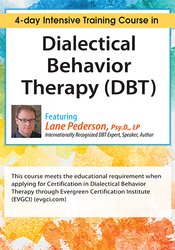

Dialectical Behavior Therapy (DBT) has evolved from the go-to treatment for borderline personality disorder to one of the most recognized and sought after therapies for a variety of difficult to treat client problems. The increasing pressure to adopt treatments that work makes DBT skills and strategies a must-have for all types of therapists.
For those who feel that pressure but fear becoming a “manual manic”, relax. Dr. Lane Pederson teaches how to follow the manual yet make thoughtful customizations consistent with evidence-based practices and always grounded in the therapeutic alliance. Covering DBT from theory to clinical application, including the use of diary cards, behavioural analysis, contingency management, and multi-layered validation, this intensive course welcomes those implementing DBT in standard and adapted ways as well as those wishing to simply add DBT skills and techniques to their eclectic or integrative style.
If you have felt limited or stuck with your therapy skills or ready to give up on certain clients, this course recording will breathe new life into your work.
You will finish this program ready to use the essentials of DBT listed above as well as skills from the Mindfulness, Distress Tolerance, Emotion Regulation, and Interpersonal Effectiveness modules with your clients, enjoying new confidence in and effectiveness with your clinical skill set.
Lane Pederson, Psy.D., LP, is not affiliated or associated with Marsha M. Linehan, PhD, ABPP, or her organizations.
| File type | File name | Number of pages | |
|---|---|---|---|
| Manual - DBT 4-Day Intensive Training Course (5.6 MB) | 116 Pages | Available after Purchase | |
| DBT Intensive Handouts (7.10 MB) | 74 Pages | Available after Purchase | |
| DBT Intensive Handouts - French (7.10 MB) | 74 Pages | Available after Purchase | |
| Modules 1-5 Manual |DBT 4-Day Intensive Training Course - French (5.62 MB) | 116 Pages | Download | |
| DBT Intensive Handouts - Italian (7.10 MB) | 74 Pages | Available after Purchase | |
| Modules 1-5 Manual |DBT 4-Day Intensive Training Course - Italian (5.62 MB) | 116 Pages | Download | |
| DBT Intensive Handouts - German (7.10 MB) | 74 Pages | Available after Purchase | |
| Modules 1-5 Manual |DBT 4-Day Intensive Training Course - German (5.62 MB) | 116 Pages | Download | |
| DBT Intensive Handouts - Spanish (7.10 MB) | 74 Pages | Available after Purchase | |
| Modules 1-5 Manual |DBT 4-Day Intensive Training Course - Spanish (5.62 MB) | 116 Pages | Download |

Lane Pederson, PsyD, LP, C-DBT, has provided Dialectical Behavior Therapy (DBT) training and consultation to over 30,000 professionals in the United States, Australia, South Africa, England, Canada, Mexico, and the Middle East through his training and consultation company, Lane Pederson and Associates, LLC (www.DrLanePederson.com). A real world practitioner, Dr. Pederson co-owns Mental Health Systems, PC (MHS), one of the largest DBT-specialized practices in the United States with four clinic locations in Minnesota (www.mhs-dbt.com). At MHS, Dr. Pederson has developed DBT programs for adolescents, adults, people with dual disorders, and people with developmental disabilities. He has served as clinical and training directors, has directed practice-based clinical outcome studies, and has overseen the care of thousands of clients in need of intensive outpatient services.
Dr. Pederson’s DBT publications include The Expanded Dialectical Behavior Therapy Skills Training Manual, 2nd Edition: DBT for Self-Help and Individual & Group Treatment Settings (PESI, 2017); Dialectical Behavior Therapy: A Contemporary Guide for Practitioners (Wiley, 2015); Dialectical Behavior Therapy Skills Training for Integrated Dual Disorder Treatment Settings (PESI, 2013) and The DBT Deck for Clients and Therapists: 101 Mindful Practices to Manage Distress, Regulate Emotions & Build Better Relationships (PESI, 2019).
Notable organizations he has trained for include Walter Reed National Military Hospital, the Federal Bureau of Prisons, the Ontario Psychological Association, the Omid Foundation, and Psychotherapy Networker. He has provided DBT training for community mental health agencies, chemical dependency treatment centers, hospital and residential care settings, and to therapists in forensic settings. Dr. Pederson also co-owns Acacia Therapy and Health Training (www.AcaciaTraining.co.za) in South Africa. Dr. Pederson currently serves on the advisory board for the doctorial counseling program at Saint Mary’s University of Minnesota and is a peer reviewer for Forensic Scholars Today.
Lane Pederson is not affiliated or associated with Marsha M. Linehan, PhD, ABPP, or her organization.
Speaker Disclosures:
Financial: Lane Pederson maintains private practice and is the founder and CEO of Dialectical Behavior Therapy National Certification and Accreditation Association. He receives compensation as a national speaker and receives royalties as a published author. Lane Pederson receives a speaking honorarium, recording, and book royalties from Psychotherapy Networker and PESI, Inc. He has no relevant financial relationships with ineligible organizations.
Non-financial: Lane Pederson serves as an advisory board member to St. Mary's University Doctoral Program in Clinical Psychology.
Foundations of DBT
Dialectical Philosophy. What IS it, and HOW is it Used?
Core Assumptions of DBT: Shaping the Therapy
DBT Models: Standard and Beyond
Biosocial Theory: Guiding the Therapy
Getting Started: Therapy Structure
Special Populations and Settings
Mindfulness and DBT
DBT Skills Training
Mindfulness: The Path to Wise Mind
Teaching Dialectics
Distress Tolerance
Emotion Regulation
Interpersonal Effectiveness
Supplemental and Updated Skills and Modules
Diary Cards
Behavioural Analysis (Chain Analysis)
Starting Out: Commitment Strategies Validation
Change Interventions
Exposure Techniques
Communication Styles
Consultative Group and Treatment Teams
Assess and Manage Self-Injurious Behaviour (SIB)
Assess and Manage Suicidal Ideation (SI)
Hospitalization Issues
Next Steps
Please wait ...